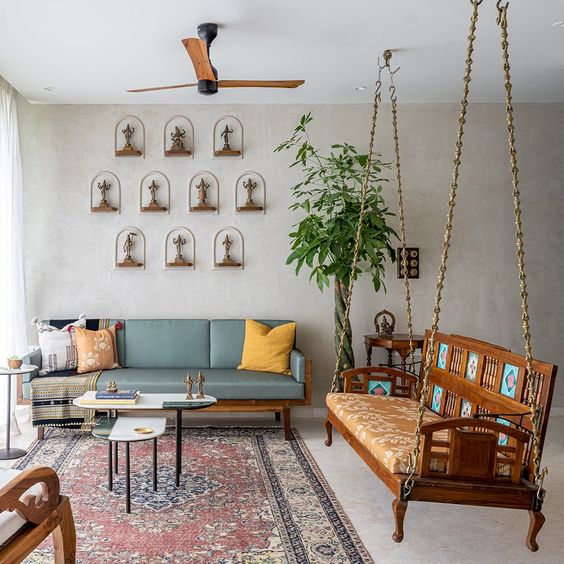Subtotal: $340

Indic Interiors: A Rising Design Trend Celebrating India’s Rich Heritage
In recent years, there has been a resurgence in home decor that reflects a distinctively Indian identity. Known as Indic Interiors, this trend is an amalgamation of ancient Indian craftsmanship, cultural symbolism, and modern functionality. Rooted in the deep cultural heritage of India, it reintroduces traditional design elements into contemporary settings, creating homes that are vibrant, soulful, and steeped in history.
What is Indic Interiors?
Indic Interiors encapsulates a design style that draws inspiration from India’s diverse regional cultures, history, and craftsmanship. It incorporates the rich textures, patterns, and colors that are characteristic of Indian culture, while blending them with modern-day sensibilities. This trend goes beyond aesthetics; it’s a homage to India’s cultural diversity, its ancient traditions, and the artistic expressions of its people.
Indian interior design has always been a reflection of the country’s vibrant and eclectic spirit, and now, with the trend of Indic Interiors, there’s a move to embrace and reinterpret this richness in ways that fit contemporary spaces. It's a style where traditional craftsmanship, intricate patterns, natural materials, and bold colors harmonize with minimalist and modern elements.
Essential Elements of Indic Interiors
- Vibrant Colors: The hallmark of Indic interiors is the use of bold, saturated hues. Deep reds, mustard yellows, peacock blues, and earthy greens are common choices, reflecting the vibrant landscapes and festive spirit of India. These colors are often paired with gold or metallic accents to create a sense of opulence and warmth.
- Traditional Textiles and Fabrics: Indian textiles, such as handwoven silk, khadi, ikat, and block-printed cotton, are integral to Indic design. Cushions, curtains, and upholstery made from these materials add texture and pattern, instantly transporting one to the streets of Rajasthan, the looms of Varanasi, or the vibrant markets of Gujarat.
- Intricate Craftsmanship: Whether it’s wooden carvings, metalwork, or intricate jali patterns, Indic interiors celebrate craftsmanship. Furniture with detailed carvings, hand-painted ceramic tiles, brass lamps, and sculptures of deities are popular additions. These elements not only add aesthetic value but also narrate a story of India's artisanal heritage.
- Natural Materials: Indic interiors often feature natural materials like wood, stone, and clay. These elements ground the space and connect it to nature. Wooden furniture with a rustic finish, terracotta decor pieces, and stone flooring or accents are common features. The organic feel of these materials contrasts beautifully with the more ornate aspects of the design.
- Spiritual Symbols and Art: India’s deep-rooted spirituality is often reflected in its interiors. Decorative motifs inspired by nature, mythological figures, and religious symbols such as lotus flowers, elephants, and peacocks are frequent. Murals, sculptures, and paintings of gods, goddesses, and folklore also enhance the thematic richness of Indic interiors.
- Furniture and Decor with a Story: Vintage furniture pieces, heirlooms, and antique artifacts often find a place in Indic interior designs. These items, steeped in history and craftsmanship, give spaces character and a sense of continuity with the past. Whether it’s a traditional charpai, a brass-inlaid table, or an antique jharokha (window), these elements add authenticity.
Why is This Trend Catching Up?
The rise of the Indic Interior trend can be attributed to several factors. Firstly, there is a growing desire among homeowners to reconnect with their cultural roots. In a globalized world, where design styles often seem homogenized, Indic interiors offer a distinct, localized aesthetic that reflects a sense of belonging and identity.
Secondly, there is a renewed appreciation for handmade, artisanal products. As more people become environmentally conscious, the demand for sustainably made, handcrafted items has surged. Indic interiors emphasize local craftsmanship, supporting traditional artisans and promoting eco-friendly materials.
Thirdly, the COVID-19 pandemic has transformed how we view our homes, leading to a rise in nostalgia and comfort-driven designs. People are increasingly looking for interiors that evoke warmth, memories, and a sense of calm. The rich colors, cozy textiles, and organic materials of Indic interiors cater perfectly to this emotional need for comfort and familiarity.
Finally, Indic interiors are becoming popular in global markets as well. With Bollywood, Indian fashion, and yoga gaining international prominence, Indian design is being recognized as sophisticated, versatile, and adaptable to global tastes. The aesthetic appeal, combined with the cultural richness, makes this trend increasingly desirable among a broader audience.
Conclusion
The Indic Interiors trend beautifully marries tradition with modernity, offering spaces that are vibrant, culturally rich, and uniquely personal. By embracing traditional crafts, bold colors, and organic materials, this design style not only pays homage to India's heritage but also serves as a reminder of the timeless appeal of handmade artistry. As the world becomes more connected, the desire to infuse homes with cultural significance and warmth is driving the popularity of Indic Interiors, ensuring its place in the global design landscape.

 Velvet Teal Blue
Velvet Teal Blue





